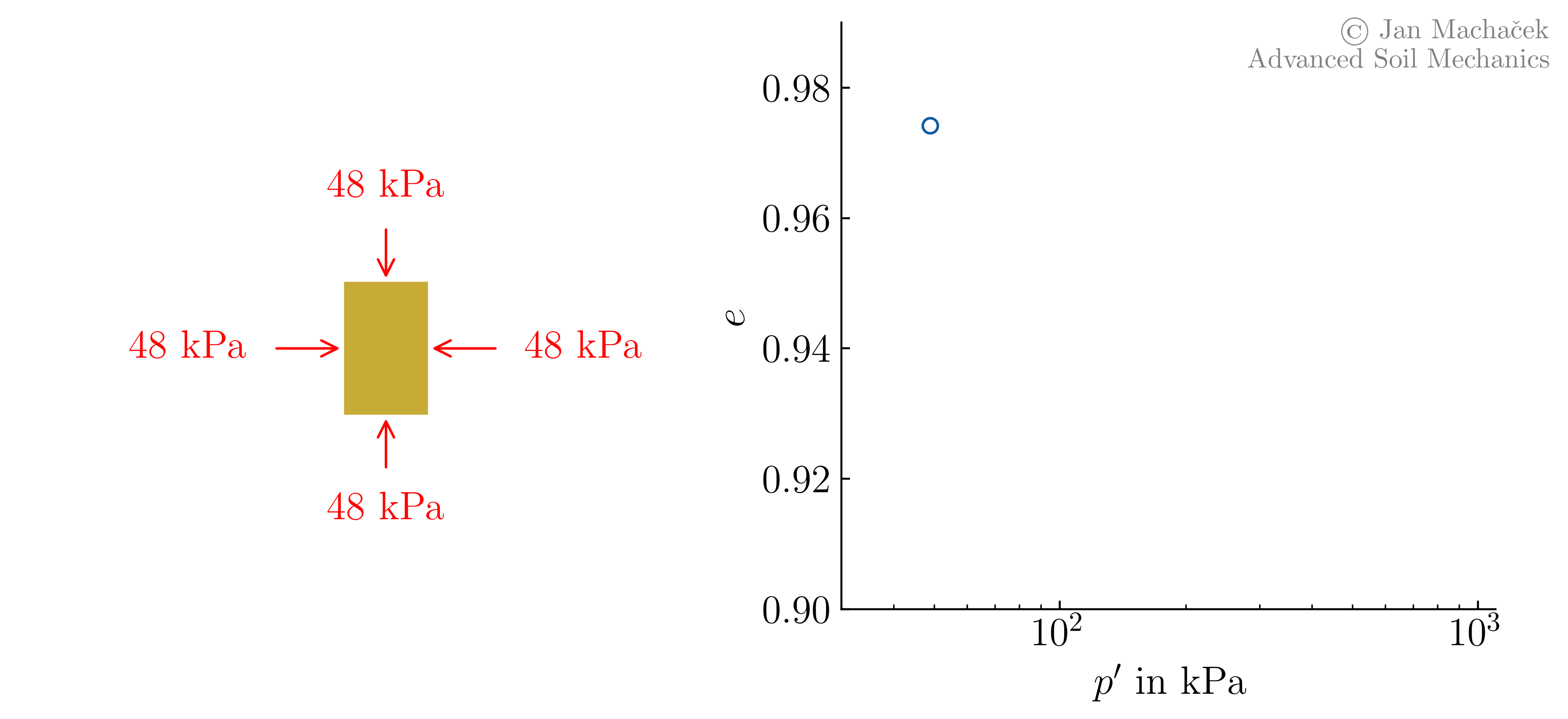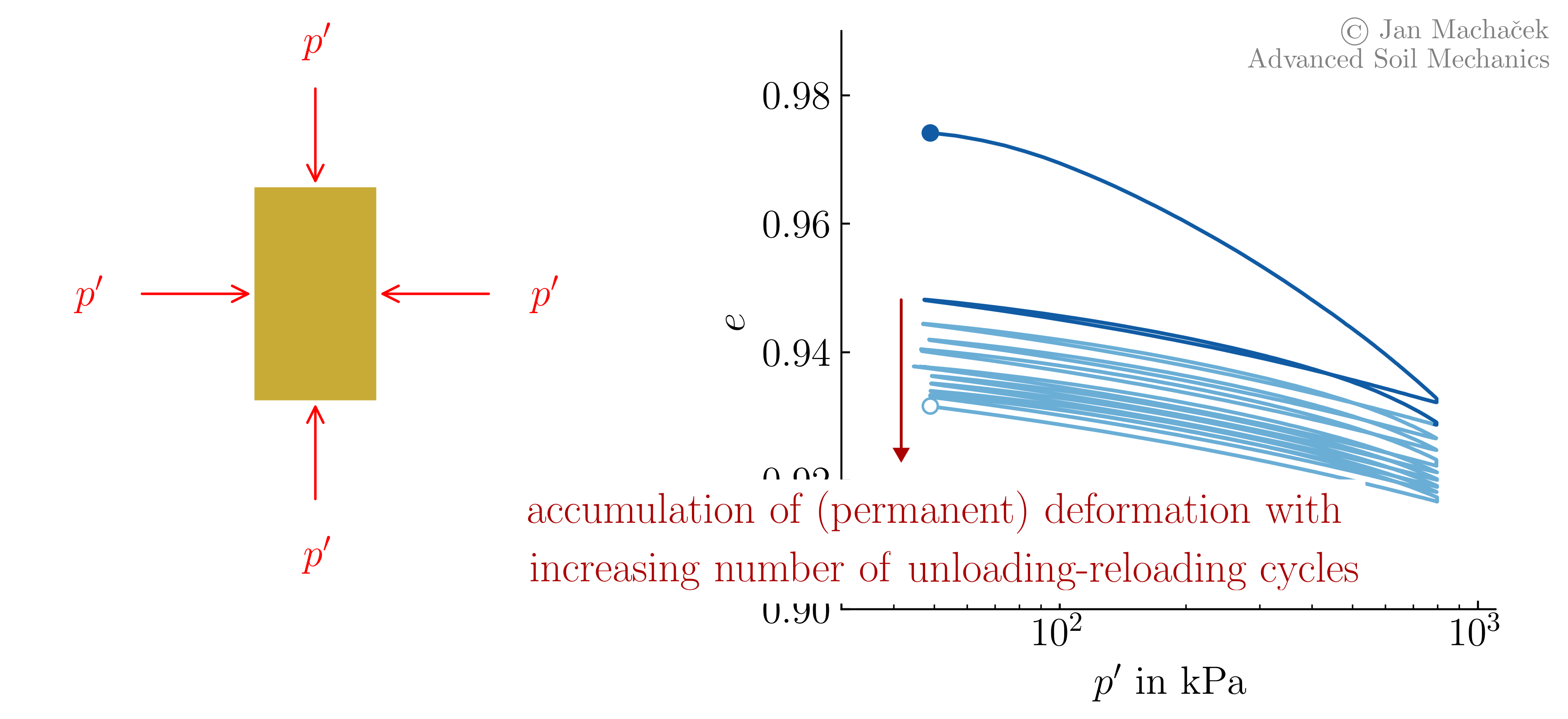Cyclic and dynamic loading
In previous lectures (both in this course and in your previous studies), the focus has been on soil behaviour under loads that are constant in their direction of action (see the monotonic triaxial test, but also the layer-by-layer backfilling of an embankment) or that have only a few changes in their direction of action (e.g. the construction of a foundation with previous soil excavation).
Your first contact with loading and unloading was in the GT I lecture, when you looked at settlement calculations and the associated soil stiffness. In this context, you have already learnt from compression tests (e.g. oedometer tests) that the soil has a lower stiffness (i.e. undergoes greater deformation) during primary loading than during unloading and reloading. This is illustrated in the following animation of a drained isotropic compression test with three loading stages: loading, unloading and reloading.
 Drained isotropic compression test ($\sigma_1^\prime=\sigma_3^\prime=p^\prime$) with loading, undloading and reloading on Karlsruhe Finesand (click to play)
Drained isotropic compression test ($\sigma_1^\prime=\sigma_3^\prime=p^\prime$) with loading, undloading and reloading on Karlsruhe Finesand (click to play)
The animation above shows the typical history-dependent stiffness of soils. The stiffness during primary loading, i.e. loading that the soil has not experienced in its history, is lower than during unloading or reloading. As a consequence, much larger deformations are observed during primary loading. The large difference in stiffness between primary loading and reloading leads to a common simplifying assumption that the soil behaves elastically during unloading or reloading. Even though the observed deformations are significantly lower than during primary loading, it is also clear from the above figure that the deformations are not purely elastic.
What happens if the loading and unloading is repeated several times in a row? Will we observe further deformation (change in void ratio) in the sample or will the sample behave elastically as we have an exact repetition of the loading history and the soil has already experienced the applied loads? The results of such a test are given below.
 Drained isotropic compression test ($\sigma_1^\prime=\sigma_3^\prime=p^\prime$) with multiple unloading-reloading cycles on Karlsruhe Finesand
Drained isotropic compression test ($\sigma_1^\prime=\sigma_3^\prime=p^\prime$) with multiple unloading-reloading cycles on Karlsruhe Finesand
The above test results clearly show that soils under cyclic loading and drained conditions experience a (small) increase in (volumetric) deformation with each (unloading and reloading) cycle. The decrease in void ratio is clearly visible here. The increase in deformation with each cycle is also called accumulation and is more pronounced in loose or normally consolidated soils than in dense or over-consolidated soils.
Indeed, many of us have encountered a similar phenomenon through everyday experiences. Take, for example, the common scenario of transferring rice or oatmeal from a packet into a jar. Often, it seems as though the jar, despite appearing sufficiently large, cannot accommodate the entire contents of the packet. Instinctively, many of us resort to gently tapping the jar on the countertop or lightly tapping its sides with a wooden spoon. This simple action effectively compacts the rice or oatmeal, making room for the remainder of the contents to fit in seamlessly.
Cyclic vs Dynamic
As the loading sequence of undloading and reloading in the example of the isotropic compression test is repeated several times, i.e. it is periodic, we refer to it as cyclic loading. In my experience, the definition of "cyclic" loading in the national and international context is not clear and often leads to misunderstandings or difficulties in communication. This is particularly true of the distinction between "cyclic" stress and "dynamic" loading. In the following we attempt to categorise these terms and illustrate them with examples.
In general, cyclic loading refers to the repeated application of load on soil in a regular and alternating manner. The load varies between maximum and minimum values, often symmetrically around a mean stress level, although not always. Cyclic loads have a specific return period and duration of action, which can vary widely. The load is applied slowly enough that we don't need to consider inertial effects. These loads can come from various sources, like mechanical or hydraulic forces. Examples of cyclic loading are:
- The repeated filling and emptying of the lock chamber of ship locks with water to raise or lower ships. This event occurs several times a day (e.g. 10 times) and lasts several minutes.
- Seasonal groundwater fluctuations. These may repeat every three quarters of the year, for example, and last about three months.
- Temperature-induced loading on steel or reinforced concrete structures causes expansion and contraction. Annually, this cyclic loading might be significant in the summer months, lasting for approximately three months with a return period of nine months. On a daily scale during these months, the structure heats up and expands during the day and cools down, contracting at night. Here, the loading duration is roughly 8 hours, with a return period of 12 hours.
Similar to cyclic loading, dynamic loading involves loads that change over time. However, dynamic loads differ as they act quickly and cause significant inertial effects, leading to the formation and propagation of waves in the soil. A key aspect of dynamic loading is the soil's damping properties, crucial for wave propagation but not typically influential in cyclic loading as defined above. Unlike cyclic loads, dynamic loads often vary in both magnitude and direction and are generally non-repetitive and transient. Examples of dynamic loading include:
- Earthquake. During an earthquake, compression-, shear- and Rayleigh-waves develop and propagate through the soil from the epicentre (the source of the earthquake) to the surface. The soil particles' movement in this case, which represents the load, can be very irregular and vary greatly in magnitude.
- Vibrations from machinery are transmitted into the ground through the foundations. These are typically of low magnitude but high frequency, e.g. 30 Hz, so that inertial effects cannot be neglected a priori.
A notable subset of cyclic loading is high-cyclic loading. This type of loading differs from standard cyclic loading in that it involves a very large number of loading cycles (often exceeding 1000) with relatively small amplitude. Despite the modest amplitude, there is an accumulation of permanent deformation over time. Although the permanent deformation per cycle is small, it generally never reaches zero. As a result, significant total deformation can accumulate across the numerous cycles. One critical concern in high-cyclic loading is the development of differential settlements, which can compromise the serviceability of structures. Common examples of structures exposed to high-cyclic loading include the foundations of offshore and onshore wind turbines, oil or liquefied natural gas (LNG) tanks, and ship locks.
Outline of this chapter
Following this introduction, we will first focus on the behaviour of the soil under untrained cyclic loading. Then, in an introduction to soil dynamics, we will learn the basics of wave propagation in soil and the damping properties of soils... more to come